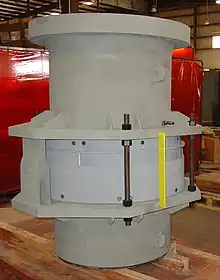A hinged expansion joint is a metallic assembly, that can rotate in a single plane, used to absorb changes resulting from piping thermal expansion or contraction.[1]

They include hinges, attached to the expansion joint ends with a pair of pins, which allow angular movement in a single plane, restrain the pressure thrust, and prevent the expansion joint from deflecting axially, either in extension or compression.[2] It is recommended that the hinges should be used in sets of two or three.[3] The expansion joint hinges provide for angular movement and will resist pressure thrust forces.[4]
Individual hinged expansion joints used in piping systems are restricted to pure angular rotation by its hinges. As a pair, hinged expansion joints will function together to absorb lateral deflection. Advantages of hinged expansion joints are that they are typically compact in size and structurally rigid.[5]
Applications
- Air, Steam, & Flue Gas Ducts
- Power Plants
- Chemical Industry
- Gas Turbine System
- Petrochemical Industry
- Primary reformer ducts & burners[6]
- Steel Plants
References
- ↑ Standard Specification for Circular Metallic Bellows ASTM F1120 - 87(2010), (retrieved 1 November 2010)
- ↑ Hinged Expansion Joint U.S. Bellows, Inc.-Manufacturer, (retrieved 1 November 2010)
- ↑ Glossary of Terms U.S. Bellows, Inc.-Manufacturer, (retrieved 1 November 2010)
- ↑ Expansion Joints - Types & Selection Charisma Global Network Pvt., Ltd., (retrieved 1 November 2010)
- ↑ Standards of the Expansion Joint Manufacturers Association, Inc., Ninth Edition, p. 2-19
- ↑ Steam Traps, Expansion Joint Maintenance Engineering, (retrieved 1 November 2010)